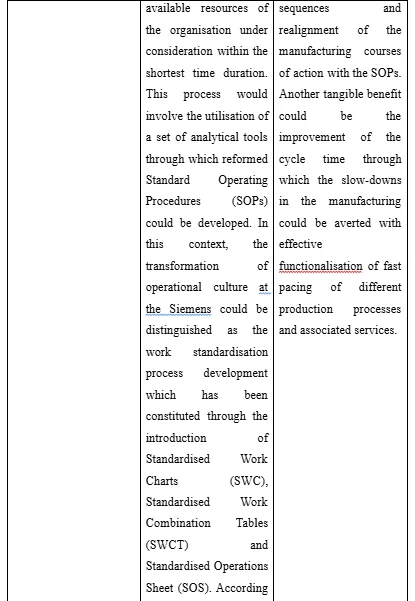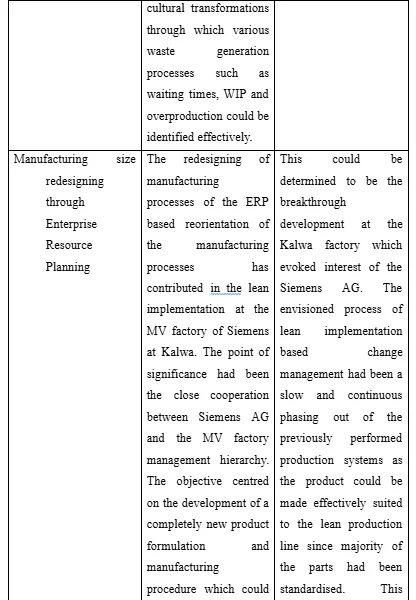Lean Manufacturing: Minimizing Waste at Siemens
Introduction
Lean manufacturing process implementation could be comprehended as the combination of a series of different methods which are designed for the purpose of actively minimise the wastage of resources, both in terms of labour and material, while preserving and expanding production levels. The objective is the improvement in the total productivity of concerned business process. The underscoring procedures could be identified to be manufacturing on the basis of just in time management and the utilisation of the minimum inventory. The emphasis is on the minimisation of downtime as well as transportation costs and maximised supervision through human workforces. In this context, the corresponding research study would be concentrating on the review of available literature concerning the lean implementation management issues at the Siemens Plant of electrical apparatus manufacturing at Kalwa.
Literature review
As per the research of Nallusamy (2016), the primary definition of Lean practices in the manufacturing and business sectors is the sum total of different waste reduction techniques. On the other hand, the observations of Tortorella, Vergara and Ferreira (2017) have outlined the primary characteristic of lean process implementation being the maximisation of value of any product or service through absolute minimisation of waste material. Furthermore, Tortorella et al (2018) have determined the principles, underscoring lean operations processes in the manufacturing and other industries (secondary and tertiary sectors), to be indicative of the significance of the value of any service or product which, could be perceived by the consumers/customers and then, the readjustment of the production in-line flow to better orient such processes with the preferences of the customers without incurrence of cost overheads. The shared scheme of objectives in all of such definitions could be understood to be, the strive by the lean manufacturing processes, to achieve perfection through persistent and continuous improvement of the production systems. This could be better explained to be the investment of effort towards the sorting out of the Non-Value Added activities (NVA) and Value Added activities (VA). Jasti and Kodali (2016) have specified that the NVA activities are primarily associated with the following in terms of any manufacturing facility such as Siemens plant at Kalwa:
1: Improper inventory management.
2: Transportation costs.
3: Redundancy of overproduction.
4: Over processing of raw materials which could prove to be in excess of the amount required to meet the existing necessity.
5: Defective production methods.
Such NVA activities put up hurdles for the waste management efforts underscored by the VA functionalities. This has been the context though which the significance of successful implementation of lean manufacturing and management elements could be perceived concerning the Siemens plant at Kalwa. To this effect, Deepak, Srivatsan and Samsingh (2017) have observed that the best practices as well as the critical factors of success of lean implementation management as the following:





Implementation of Lean at Kalwa plant
Lean implementation process at Siemens plant at Kalwa involved the adoption of lean methodologies and subsequent changes involved support systems changes, layout alterations, readjustment of vendor management and cultural changes. Mostafa, Dumrak and Soltan (2013) have determined that factory layout changes have been the following:
1: The explanation of the visions behind such initiatives of lean implementation based changes.
2: Demonstration of the commitment of the management hierarchy towards successful management of the lean implementation project through modification of the factory layout within 23 hours which involved the changing of factory assembly lines manufacturing the panels and IVCBs and also the shifting of the store positions.
3: Introduction of the assembly line concepts with the formulation of five assembly lines and 6 assembly workstations.
4: Time required to operate per workstation was stipulated at the threshold of 1 hour and the work procedures were adjusted accordingly.

The support systems changes included extensive modifications from the SOE to the dispatch sections and involved the following:
1: Dashboards were utilised for the purpose of exhibitive communication of issues by both engineers and workers with the mentioning of particular names of associated personnel along with their associations with the issues
2: Half hour meetings were conducted with such personnel by the top management of the Kalwa plant of Siemens.
3: The root causes of the production errors and slowdowns as well as other issues were explored and the holistic conditions as well as the implications of shortcomings were shared to the personnel attached to different operations segments such as SOE, design, material planning and engineering.
4: Dashboards exhibited the progression reports of production lines for the managers to take cognisance. Sunrise meetings of 1 hour of duration were scheduled for each day to address the outlined issues and the associated personnel were tasked with analysing the root causes of such problems through 6 laws of root cause analysis to develop a proper solution.
5: The institution of employee skill assessment test was initiated to determine the gaps in skill sets of employees. The outcome of the same transpired as lecture sessions by members of lean management training groups and consultants, group exercises for training employees for value mapping and providing information on procedures such as Kaizen, 5S and others.
6: Workplace audit management training programmes were also undertaken.
Vendor management changes had been the following at the Siemens Kalwa plant:
1: Visitations were held to each of the vendors by the factory lean team so as to inform them of all of the benefits of lean program implementation since the vendors were poised to experience serious challenges to their supply of materials due to the loss of the economy of scale as the issuing of BOMs for combined orders had been discontinued now at the Kalwa plant.
2: The vendors were taken into confidence with promises of greater numbers of orders as the factory was poised to increase production capacity due to the lean process implementation.
3: The compromise in the form of temporary arrangement of simultaneous bulk manufacturing by vendors and delivery to the factory as per the emergence of requirements could was arrived at. This solution highlighted the pull philosophy of the lean management system in the form of sourcing of materials from the vendors on the basis and time of requirements.
The cultural changes experienced could be demonstrated as the following:
1: Inception of joint exercise and prayer offering sessions. This intended the improvement of sense of belonging within the team members including the groups and working personnel as well as the floor engineering staff.
2: Lean project management personnel were provided with uniform dress codes. This adhered to the sense of team cohesion and joint effort on part of the working personnel and the management staff.
3: Workers were also issued with particular uniforms later.

Strengths and Weaknesses of Siemens lean Implementation
The strength of the lean manufacturing process implementation at the Siemens could be perceived, as per Nordin et al (2012), as the compatibility of the product with the lean production line since most of the product components had been standardised. Another strength of the lean implementation project at the MV factory at Kalwa plant of Siemens had been the Redesign Project. As has been mentioned earlier, the redesigning project concentrated on the reduction of variations in the newly developed product as well as the associated cost reduction purposes. The technical viability tests (type tests) were implemented for this purpose.
Furthermore, the lean production line manufactured both the old products with all of the previous variations and the new products as well. This was another strength of the lean production implementation process since the integration of the lean line with the new product was achieved effectively. Puvanasvaran et al (2009) have outlined the effective benefits of the lean production based changes observed at the Siemens MV factory at Kalwa in the form of the reports highlighted by the KPIs (Key Performance Indicators) which had been further reported to the Siemens AG management per month by the Kalwa plant management and lean implementation team members. The KPIs consisted of the operational, qualitative, human resource and financial performance parameters. The data derived from the KPI parameters directed the subsequent actions involving the Continuous Improvement (CI) of the quality of production and for the application of effective corrective measures so that inefficiencies could be made away with. Thus, the KPIs also were associated with perceptions of the plant working personnel, demonstrated capabilities of adaptation, team work process improvement, engagement initiatives of the leaders and motivations as well as training of the workforces for the purpose of improvement. All of the departments of the factory plant had to submit their KPIs to the monitoring team which had been formulated for the purpose of reviewing such reports.
The case study has highlighted that KPI sheets had commenced demonstration of improvements from September 2008 onwards. The strength of the lean production systems had been registered as the reduction of panel throughput time by 30% on the shop floor and the increment of First Pass Yield by 40% along with the increment of work productivity by 30%. The One Piece Flow based Pull system of the lean manufacturing management ensured the prevention of unnecessary and redundant inventory formulation at the various work stations since each of the stations had their work particulars clearly defined.
Suggestions to Improve lean Implementation of the Siemens plant
The suggestions have been formulated on the basis of Enterprise Resource Planning based propositions as the following:



Conclusion
The best practices of lean management implementation have been delved into with critical evaluation of the lean approaches undertaken in the Siemens MV plant at Kalwa, identification of the weaknesses and strengths of the lean implementation processes and development of credible and relevant suggestions regarding the lean implementation procedural improvement within the concerned plant have been also performed. To this effect, the study has compared the implemented lean procedural practices with the available understanding of lean management to gauge the effectiveness of the same.
Reference List
Deepak, A., Srivatsan, R. and Samsingh, V., 2017. A case study on implementation of walking worker assembly line to improve productivity and utilisation of resources in a heavy duty manufacturing industry. FME Transactions, 45(4), pp.496-502.
Hammer, J. and Kiesel, M., 2019. A TRIZ and Lean-Based Approach for Improving Development Processes. In Advances in Systematic Creativity (pp. 101-114). Palgrave Macmillan, Cham.
Jasti, N.V.K. and Kodali, R., 2016. An empirical study for implementation of lean principles in Indian manufacturing industry. Benchmarking: An International Journal, 23(1), pp.183-207.
Mostafa, S., Dumrak, J. and Soltan, H., 2013. A framework for lean manufacturing implementation. Production & Manufacturing Research, 1(1), pp.44-64.
Nallusamy, S., 2016. Lean manufacturing implementation in a gear shaft manufacturing company using value stream mapping. In International Journal of Engineering Research in Africa (Vol. 21, pp. 231-237). Trans Tech Publications.
Nordin, N., Deros, B.M., Wahab, D.A. and Rahman, M.N.A., 2012. A framework for organisational change management in lean manufacturing implementation. International Journal of Services and Operations Management, 12(1), pp.101-117.
Puvanasvaran, P., Megat, H., Hong, T.S. and Razali, M.M., 2009. The roles of communication process for an effective lean manufacturing implementation. Journal of industrial engineering and management, 2(1), pp.128-152.
Tortorella, G.L., de Castro Fettermann, D., Frank, A. and Marodin, G., 2018. Lean manufacturing implementation: leadership styles and contextual variables. International Journal of Operations & Production Management, 38(5), pp.1205-1227.
Tortorella, G.L., Vergara, L.G.L. and Ferreira, E.P., 2017. Lean manufacturing implementation: an assessment method with regards to socio-technical and ergonomics practices adoption. The International Journal of Advanced Manufacturing Technology, 89(9-12), pp.3407-3418.
Vienazindiene, M. and Ciarniene, R., 2013. Lean manufacturing implementation and progress measurement. Economics and management, 18(2), pp.366-373.
- 24/7 Customer Support
- 100% Customer Satisfaction
- No Privacy Violation
- Quick Services
- Subject Experts



